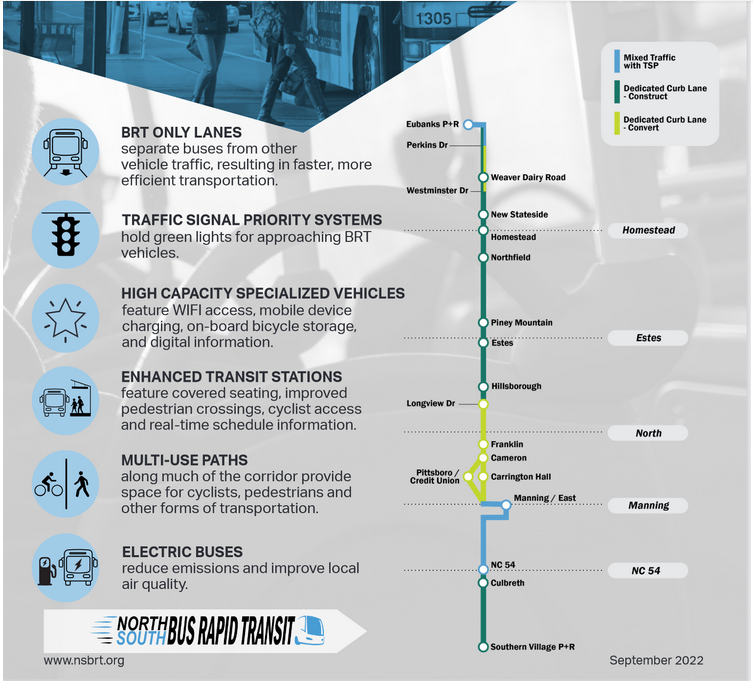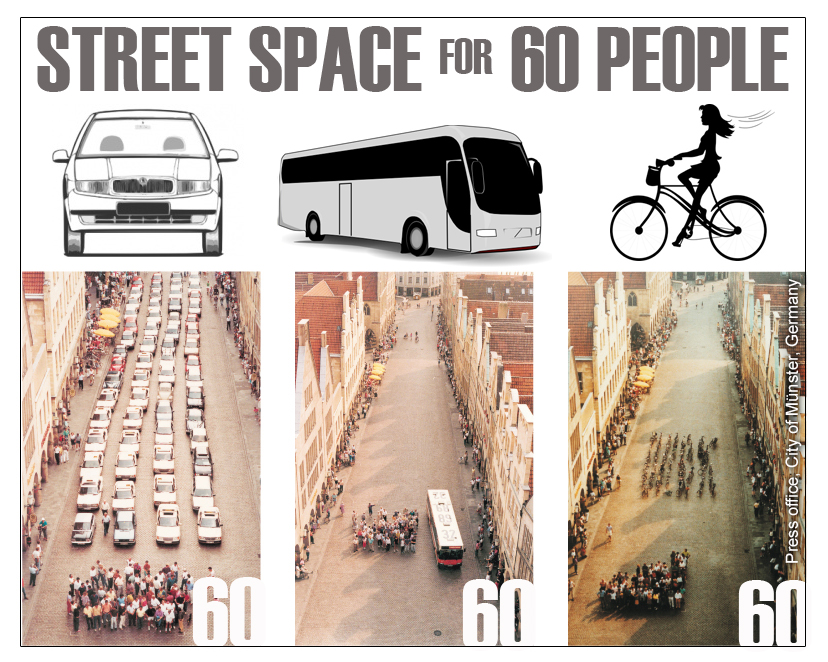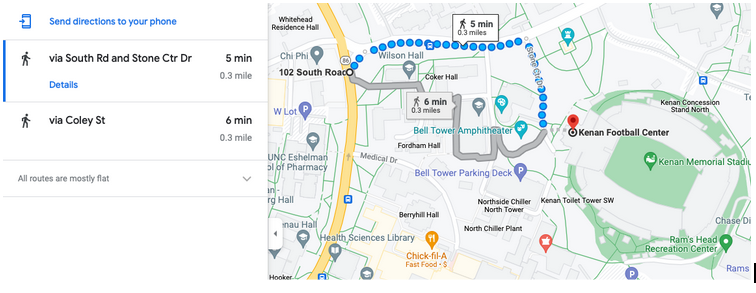We’re transit nerds, and are really excited about the planned North-South Bus Rapid Transit (NSBRT) project in Chapel Hill. This post details what the line is and how it will help transit and traffic in Chapel Hill.
First, what is Bus Rapid Transit?
If you’re reading this blog, you’ve probably been somewhere with rapid transit. Maybe you’ve ridden the LYNX light rail in Charlotte, MARTA in Atlanta, or the Metro in DC. What makes them rapid transit? Three things:
Dedicated track
If you’re riding the Metro, you’re not going to get stuck because a freight train is using the track in front of you. All the track is used exclusively by Metro.
Regular service
While times vary, typically MARTA trains run every ten minutes during rush hour, and every twenty minutes when it’s less busy.
Stations
When you ride the LYNX rapid transit, you go to a station, where it’s pleasant and safe to sit and wait to get to your destination.
Bus Rapid Transit (BRT) features all of the above, but the system uses buses instead of trains. You get most of the good things about rapid transit—a dedicated lane, regular service, and stations—but it’s much cheaper to build and operate. Cities all over the U.S. from Richmond, Virginia to Orlando, Florida, have opened BRT lines, with great results.
Okay, what is the North-South Bus Rapid Transit (NSBRT)?
The North-South BRT will be Chapel Hill’s first Bus Rapid Transit line, connecting the Eubanks Park and Ride with the Southern Village Park and Ride.
For current bus riders, you know it as the NS route. But the NSBRT will be faster, more reliable, and nicer in all ways, from the moment you arrive at the station to the time you arrive at your destination. There will also be a multi-use path on both sides along most of the route (except for downtown, which already has sidewalks), connecting you safely to your destination after getting on or off the bus.
Here’s a map:

How is it different than the NS bus?
The bus will have its own lanes along most of the route
As part of the project, curb running dedicated lanes for the bus are being constructed or converted (except through campus). This allows the bus to stay on schedule any time of day.
Along with dedicated lanes, the BRT will enjoy traffic signal priority (TSP)
This means that if a traffic signal receives a wireless message that a transit vehicle is approaching, green lights will be held a bit longer and red lights will change to green a little faster. This helps keep BRT on schedule!
The stations will be level with the bus entrances
This means that people who use mobility scooters, a bike, or have a sleeping kid in a stroller, will be able to get in and out of the bus without any trouble. This makes boarding time faster and more accessible for everyone.
Premium station amenities will be included
This could include secure and sheltered bike parking, wifi, charging stations, water filling stations, and more.
We’re getting a multi-use path!
A multiuse path is being constructed as part of the project on both sides of the route (with the exception of downtown and campus which already have sidewalks).
Do you live between two stations? No worries, you’ll have a safe, easy way to get there and home again, whether you’re walking, biking, or rolling.

Added service, including at night and on weekends
If you want to go out to eat downtown at 8 pm, you can take the bus and not have to worry about getting back at a reasonable hour. And you won’t have to pay to park!
Real-time schedule information
While it’s coming back soon to Chapel Hill Transit, BRT stations and vehicles will feature integrated vehicle tracking and real time schedule information. You’ll never have to wonder when the next bus is arriving!
An all-electric BRT fleet of vehicles
Why are we excited about this?
Because buses make Chapel Hill a great place to live, and the BRT will make it even better. Already, Chapel Hill Transit is the second largest transit system in North Carolina, with more than 3,000,000 (!) trips taken each year.
Our bus has been fare-free for twenty years, and tens of thousands people rely on it to get to UNC’s campus and other destinations in Chapel and Carrboro everyday.
The NSBRT will supercharge this success by creating rapid and reliable service along one of the town’s busiest travel corridors. The town is already working on plans to support more housing, jobs, and services within walking and cycling distance of the BRT stops (transit oriented development or TOD). A focus on equitable TOD (ETOD), hopefully means more people who work in Chapel Hill will have the opportunity to live here, too.
Investments in high quality transit like the NSBRT makes it possible for people who work in Chapel Hill (UNC, UNC Hospitals, and businesses downtown, etc.) to rely on transit as their primary mode of transportation. This could allow a family to go from two cars to one car, or from one car to car-free, because they can rely on frequent, useful, affordable bus service.
We’re also excited because the NSBRT’s multiuse path helps connect currently disconnected neighborhoods and communities.
Imagine safely riding an electric bike from the Aquatic Center at Homestead to the Chapel Hill Public Library (connecting to the path under construction on Estes), or from a downtown coffee shop to your apartment complex on MLK. This project will make it so easy to bike, walk, and bus places that you won’t even think about driving.
I’m not planning to use the NSBRT. Are there benefits for me?
Yes! Even though many people use the bus, a majority of riders are UNC employees and students. Where does that leave folks who don’t work in Chapel Hill?
Three points for you to ponder:
More people using the NSBRT means fewer cars on MLK
Each BRT vehicle can carry at least 60 passengers. At peak, there will be around nine BRT vehicles operating. If each passenger in each of those buses were driving their own cars, that would mean 60 more vehicles on the road FOR EACH OF THE NINE BUSES. This has both congestion AND environmental benefits. For reference, this is what 60 cars looks like. Now multiply that by nine.
Even if you never step foot in the bus, and you like walking, running, or riding a bike, you will have an awesome dedicated multi-use path along the BRT corridor
This path helps riders reach or leave a stop. And it also opens up active transportation options on MLK for commuters and recreational uses alike!
The ETOD plan helps the NSBRT and Chapel Hill address housing and traffic problems in one fell swoop
Without the NSBRT, traffic will get worse, meaning NCDOT will eventually propose road widenings to maintain their acceptable level of service.
This means losing A LOT of trees along MLK in the right of way. (If you need evidence, travel north on MLK, just beyond the I-40 interchange, and observe the clear cutting of forest for the widening of I-40).
Widening MLK will likely also exacerbate congestion (oh hi, induced demand). If we construct the NSBRT we can keep our trees AND support a lot more housing in areas with great transit.
What is level boarding?
While existing buses have the ability to ‘kneel’ (when the operator can lower the entire bus to sidewalk level), it takes time to lower and elevate the vehicle and contributes to the “othering” of people with disabilities. Level boarding means the station platforms and the vehicles are always aligned, making boarding and exiting the bus easier, quicker, and more comfortable for everyone on wheels or on foot.
How about sports?
One of the stations will be a six minute walk to Kenan stadium. I recently went to a Carolina football game (I rode my bike) and I saw a lot of cars in traffic snarls. Imagine parking at Southern Village or Eubanks road (depending on where you are coming from) and taking one of the buses past the traffic jam.

What is needed now?
Major capital projects like the NSBRT are most successful when funding comes from a variety of sources. Discretionary grants are available through programs like FTA’s “Small Starts” Capital Improvement Grant program, but they are extremely competitive. Funding requests are assessed based on a variety of factors, including the split between local (ie non federal) and federal contributions to the total project cost. This is typically reported as a percentage. Projects with a higher percentage of local funding are more competitive.
The NSBRT currently has very little local financial support, beyond a small amount allocated from the transit tax revenues collected by Orange County. Neither the Town of Chapel Hill, nor UNC, nor the State of North Carolina have put meaningful funding into this project. The lack of a strong local match from local partners could negatively impact the project’s standing and competitiveness.
What Can I Do To Help?
We’re glad you asked! Here are a few ways to get involved:
- Email the Mayor and Council ([email protected]) and let them know you support the project and that the Complete Community initiative should better integrate this important investment.
- Tag @unc and @uncmedcenter on Twitter and ask them to provide financial support for this project.
- Write a letter to the DTH or the News and Observer
- For goodness sake, VOTE! Especially for candidates who support investing in multi-modal transportation!